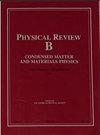载流子掺杂诱导二维材料磁相变的机理
IF 3.2
2区 物理与天体物理
Q2 MATERIALS SCIENCE, MULTIDISCIPLINARY
引用次数: 1
摘要
通过静电掺杂在二维半导体中实现了远程磁序的电调谐。另一方面,观察结果是高度多样化的:根据特定的材料,可以通过电子或空穴或两者同时实现跃迁。此外,掺杂载流子似乎总是倾向于铁磁(FM)基态。这些不同观察结果背后的机制仍未揭示。结合第一原理模拟,我们分析了带边相关d/f轨道的自旋超交换路径,并根据它们的投影态密度(PDOS)将二维磁性半导体划分为三种类型。我们发现每种类型的PDOS对应于特定的载流子驱动的磁相变,并且可以通过计算超交换耦合强度来定量地获得临界掺杂密度和载流子类型。模型结果与第一性原理计算和现有测量结果吻合良好。在了解机理后,我们可以设计异质结构来实现调频到反铁磁的转变,这是以前没有实现过的。该模型有助于理解各种测量和扩展自由度,以控制二维半导体中的远程磁顺序。本文章由计算机程序翻译,如有差异,请以英文原文为准。
Mechanism of carrier doping induced magnetic phase transitions in two-dimensional materials
Electrically tuning long-range magnetic orders has been realized in two-dimensional (2D) semiconductors via electrostatic doping. On the other hand, the observations are highly diverse: the transition can be realized by either electrons or holes or both depending on specific materials. Moreover, doped carriers seem to always favor the ferromagnetic (FM) ground state. The mechanism behind those diverse observations remains uncovered. Combining first-principles simulations, we analyze the spin superexchange paths of the correlated d/f orbitals around band edges and assign 2D magnetic semiconductors into three types by their projected density of states (PDOS). We find that each type of PDOS corresponds to a specific carrier-driven magnetic phase transition and the critical doping density and type of carriers can be quantitatively obtained by calculating the superexchange coupling strength. The model results are in good agreements with first-principles calculations and available measurements. After understanding the mechanism, we can design heterostructures to realize the FM to antiferromagnetic transition, which has not been realized before. This model is helpful to understand diverse measurements and expand the degrees of freedom to control long-range magnetic orders in 2D semiconductors.
求助全文
通过发布文献求助,成功后即可免费获取论文全文。
去求助
来源期刊

Physical Review B
PHYSICS, CONDENSED MATTER-
CiteScore
6.30
自引率
32.40%
发文量
4177
期刊介绍:
Physical Review B (PRB) is the world’s largest dedicated physics journal, publishing approximately 100 new, high-quality papers each week. The most highly cited journal in condensed matter physics, PRB provides outstanding depth and breadth of coverage, combined with unrivaled context and background for ongoing research by scientists worldwide.
PRB covers the full range of condensed matter, materials physics, and related subfields, including:
-Structure and phase transitions
-Ferroelectrics and multiferroics
-Disordered systems and alloys
-Magnetism
-Superconductivity
-Electronic structure, photonics, and metamaterials
-Semiconductors and mesoscopic systems
-Surfaces, nanoscience, and two-dimensional materials
-Topological states of matter
 求助内容:
求助内容: 应助结果提醒方式:
应助结果提醒方式:


